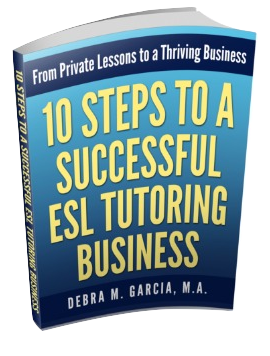Tips for Past Perfect Lesson Plans
How to Teach Past Perfect Conjugation,
Form, and Function
During my Past Perfect lesson plans, my advanced adult ESL students often tell me that they never use this verb tense, although they have studied it in the past.
In fact, ESL and EFL students can actually function perfectly well and express almost everything this tense expresses without ever using this tense! They can just use two Simple Past verbs along with some time marker words (e.g., before, after, when). But it's still important to encourage English Language Learners to practice this tense so that they can more fully express themselves.
Although it is not necessary to teach all of the following in the same class, thorough Past Perfect lesson plans should include the following:
- (1) Conjugation,
(2) Form, and
(3) Function.
This page discusses each of these components in detail.
Past Perfect Verb Conjugation
The Past Perfect is constructed this way:
- subject + had + past participle
The conjugation is fairly simple. Only the subject changes. The helping, or auxiliary, verb (had) and the past participle are the same for all subjects.
Here are some examples of Past Perfect tense verbs with the subject pronouns I, you, he/she/it, they and we.
- I had talked. I had smoked. I had danced. I had eaten.
- You had talked. You had smoked. You had danced. You had eaten.
- She/He/It had talked. She/He/It had smoked. She/He/It had danced. She/He/It had eaten.
- They had talked. They had smoked. They had danced. They had eaten.
- We had talked. We had smoked. We had danced. We had eaten.
Cloze exercises can be used for Past Perfect lesson plans to help reinforce verb conjugation for English language learners.
Past Perfect Verb Form
(five forms the English students must learn)
- Affirmative Usage (I had studied. You had studied. She/He/It had studied. They had studied. We had studied.)
- Negative Usage (I had not studied. You had not studied. She/He/It had not studied. They had not studied. We had not studied.)
- Yes/No Questions (Had I studied? Had you studied? Had she/he/it studied? Had they studied? Had we studied?)
- Short Answers (Yes, I had. No, I hadn't. Yes, you had. No, you hadn't. Yes, she/he/it had. No, she/he/it hadn't. Yes, they had. No, they hadn't. Yes, we had. No, we hadn't.)
- WH- Questions (e.g., When had she studied English? Where had he traveled? Who had you visited? What had I done? Where had they been?)
Past Perfect Function
The function of the Past Perfect is to talk about an event/activity that was completed before another event/activity or time in the past.
When using this tense, there will always be two past events or activities, or an event/activity and a particular time in the past.
Here are some sentences showing the use of the Past Perfect:
- I had already gone to bed by the time you got home.
- She had already studied English for six months when she left for the United States.
- He had finished his dessert before I even started my entrée.
- Her older brother had graduated from college before she started high school.
- We had fallen asleep by 9 o'clock.
You'll notice that the Simple Past is used in the second part of the sentences that have two events/activities.
The above sentences could also be written without using the Past Perfect tense, like this:
- I went to bed before you got home.
- She studied English for six months before she left for the United States.
- He finished dessert before I even started my entrée.
- Her older brother graduated from college before she started high school.
- We fell asleep before 9 o'clock.
Whenever "before" or "after" are used, the Past Perfect tense is optional because the sequence of events is clear. Some typical Past Perfect lesson plans ask ESL/EFL students to take two past tense events and to correctly write one sentence using the Past Perfect.
Note: The two events or the event and the particular time do not both need to be included in the same sentence when the other event/activity or time is understood from the context of the conversation.
ESL Student Challenges
Past Perfect lesson plans focusing on verb conjugation can include cloze (fill-in-the-blanks) exercises. The challenge for students will be using the correct past participle for irregular verbs. So if your focus is teaching ESL/EFL students the proper conjugation, it may be best to use regular verbs first.
Overall, ESL students have trouble using this tense easily and effectively because they don't get enough practice using it and because they can get by without ever using it!
With my private ESL students, I try to point out when they can use the Past Perfect to help reinforce the tense.
Related Article to Past Perfect Lesson Plans
For a thorough discussion on how to teach verb tenses, see Teaching ESL Verb Tenses.
Additional Teaching Resource
Azar's, Understanding and Using English Grammar
is an excellent textbook to help with Past Perfect lesson plans and all
other verb tenses. I use it regularly with my students. It includes
exercises and excellent explanations. This resource is best for
intermediate and advanced ESL or EFL learners.
From Past Perfect Lesson Plans
to Teaching ESL to Adults Home Page


New! Comments
Have your say about what you just read! Leave me a comment in the box below.